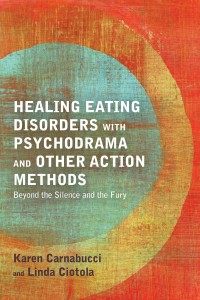JKP author Karen Carnabucci, a licensed clinical social worker and board-certified trainer, educator and practitioner of psychodrama, sociometry and group psychotherapy, discusses pacing of eating disorders and actions therapies workshops and training sessions for clients—With eating disorders and action therapy, slow is the way to go. Karen is the co-author of Healing Eating Disorders with Psychodrama and Other Action Methods: Beyond the Silence and the Fury.
When we work with people with eating disorders and dieting struggles, we suggest going slow—very slow.
Some of our clients, trainees and others are surprised about the pacing of our workshops and training sessions where we encourage meditative  breathing, mindful movement, frequent pausing during meals and dramas that proceed step by step and scene by scene. After all, psychodrama is supposed to be “dramatic” with lots of lively action—right?
breathing, mindful movement, frequent pausing during meals and dramas that proceed step by step and scene by scene. After all, psychodrama is supposed to be “dramatic” with lots of lively action—right?
Although it is true that psychodrama has sometimes been labeled with a reputation for a rat-a-tat style of dramatic scenes – which certainly can be useful in dramas that focus on play or take place in educational and theater settings – such a speedy pace is not always helpful for eating disorders treatment.
In the case of eating disorders, slow is the way to go. In our book Healing Eating Disorders with Psychodrama and Other Action Methods: Beyond the Silence and the Fury, we encourage thoughtful pacing as we seek to model to our clients another option for living.
Here is why:
- Our culture favors a certain kind of body shape and weight and level of attractiveness that is not realistic for most people to meet. This same culture promotes quick fixes and fast food at the expense of learning how to savor food, the experience of eating and the process of living. Women are encouraged to try faster dieting techniques for losing weight—28 pounds in 30 days!—and men are given quick-time promises for products and gadgets to bulk up their muscles or carve those abdominals. Being able to invest time in recovery can be an important relief for our clients who may have felt pushed and pressured most of their lives to look a certain way. When we take our time, recovery becomes not a wild race to the finish line but a slowly evolving process as the person learns to improvise new ways of responding to life’s challenges.
- The natural rhythms of the body have been greatly disrupted by disordered eating. Appetites are skewed for high or low, and the sleep cycle is often disrupted along with other basic body functions. All body systems—circulation, respiration, digestion and elimination plus the reproductive system, endocrine system and the nervous system—have subtle rhythms of their own, and we must give permission to our bodies to learn how to return to these natural rhythms. Experiencing moments of slowness with meditative walking, quiet reflection, gentle yoga poses and periods of listening interspersed by periods of action are a few of the many ways to support and integrate the experience of slowing down.
- People with eating disorders and body distress are likely to have a history of trauma, whether it is sexual abuse, childhood maltreatment, early disruptions in attachment to caregivers, such as separation from mother due to premature birth, early illness, death of mother, and intergenerational pain. When we encounter trauma as professionals we must be careful that we do not rush our clients into re-experiencing the trauma bare of strengths and resources. We like the Therapeutic Spiral Model, a modification of psychodrama for trauma survivors, which focuses on identifying and integrating personal, relational and spiritual strengths before trauma material is addressed. As the person actually experiences these strengths and resources, he or she will be able to consciously and effectively address the trauma in a manner that leads to genuine healing.
Of course, there are times when our dramas with eating disorder clients became raucous with laughter and cheers, and there may be singing and drumming or stomping of feet when the client, the drama and the developmental stage of the group properly calls for these experiences. The skilled psychodramatist will be able to move between all of these scenes and experiences to guide the client to a new life.